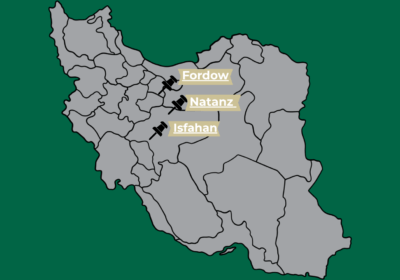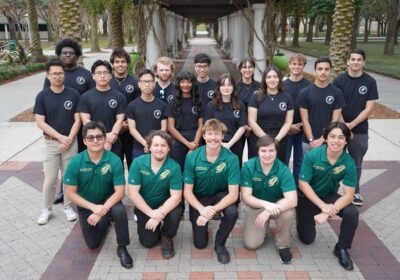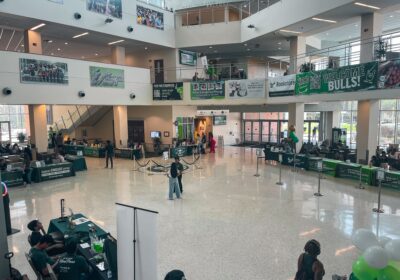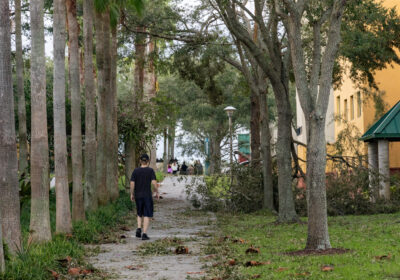CAM exhibit to raise questions about climate change
The USF Contemporary Art Museum (CAM) is combining the worlds of art and science by hosting the exhibits “FloodZone” and “Sponge Exchange” throughout February.
These events are free to the public.
“Students might consider the USF Contemporary Art Museum as a free resource,” Curator of Public Art and Social Practice Sarah Howard said in an email to The Oracle. “Similar to the campus library, that expands and broadens their perspective of the world, and their place within it, through the lens of art.”
Howard said the exhibition was important to have at the museum because of its relevance to the worldwide issue of climate change.
“Inspired by the sponge culture of Tarpon Springs and coral restoration efforts, Sponge Exchange looks to both the past and present to reveal humans’ intervention with the ocean’s ecology, while FloodZone reveals the slow and subtle changes of the ocean’s intrusion into the constructed landscape of South Florida’s coastal communities,” Howard said.
Visitors will see how the climate crisis is affecting the local community through visual media of performances, sculptures, videography and photography, and incorporating audio aspects as well.
The first event will be a showing of “Trouble Waters — A Turtle’s Tale” on the CAM lawn Feb. 6 at 6 p.m. The show will include short documentaries on how human beings affect the well-being of South Florida’s water and what lives in the water. Food and drinks will be provided to attendees.
The following week, artist Anastasia Samoylova and Brooklyn-based art historian and curator Ksenia Nouril will provide a free talk about Samoylova’s photography works will be on display and discussed.
The event will be held Feb. 13 at 6 p.m. and a reception will be followed by refreshments.
Artist Hope Ginsburg will speak at Leepa-Ratta Museum of Art in Tarpon Springs at 3 p.m. on Feb. 23 about the sponge industry of Tarpon Springs and its influence on her artwork as well as marine life in the area.
Howard said she feels as though the two artists will be a positive addition to the theme showcasing climate change by focusing on flood zones and sponge exchange.
“I think both artists hope to evoke empathy about the communities and species threatened by the impacts of the climate crisis, and in turn raise awareness, shift perspectives and catalyze the community to address the critical issues we are facing,” Howard said.
Alongside Ginsburg’s talk, there will be a performance by the “Land Dive Team: Tarpon Springs.” This will be the 14th performance of Ginsburg’s work to raise awareness of the feelings of fear that come along with climate change.
Trained scuba divers will meditate to live music while in full scuba attire. With controlled breathing patterns, the goal is to create a sound that will make listeners ponder the current state and future of the environment and those who live in it.
A three-hour musical performance will also take place Feb. 21 at CAM at 7 p.m. USF students from the School of Music Composition and Electronic Music Studio program (SYCOM) will perform in this showcase.
Along with the events, two solo exhibits, that have been running since January, are still at CAM until March 7.
The FloodZone exhibit relates back to Samoylova’s photography in the West Gallery.
The photographs are to show rising sea levels in South Florida and bring to light man-made versus natural landscapes.
“Capturing the precarious psychological state of living in a paradise sinking towards catastrophe, Samoylova’s work reveals the role photography plays in obscuring reality and crafting perception,” the CAM website said about her photography.
The other exhibit in the Lee and Victor Leavengood Gallery is an expansion of Ginsburg’s work on the sponge industry, and is appropriately named “Sponge Exchange.”
The exhibit employs the artist’s creations of both sculpture and videography that are influenced by how the history of diving for sponges as well as modern attempts of rehabilitation of coral have been affected by the climate crisis.
“‘Sponge Exchange’ also proposes a politics of collaboration for addressing the climate crisis, and offers hopeful outcomes and potential future adaptation and resilience strategies,” Howard said.
Both solo exhibitions are expected by Howard to adequately convey the message that is trying to be made.
“‘FloodZone’ and ‘Sponge Exchange’ effectively employ aesthetics, humor, irony and the surreal and sublime to engage viewers with the deeper issues the work is reflecting, and invite viewers to slow down and consider the impacts from different points of view,” Howard said.
CAM will be featuring these events and gallery exhibits throughout February to March 7 to shine a light on how climate change is affecting the local South Florida ecosystems.
“The issues surrounding the climate crisis can be overwhelming, terrorizing and paralyzing,” Howard said. “I think it’s important that we collectively continue to explore creative solutions and imaginative resilience strategies for the future to stay engaged with the issues.
“Art is a powerful tool for stimulating emotional responses to difficult and challenging issues, as it provides for many points of access and ways to communicate multiple perspectives.”







